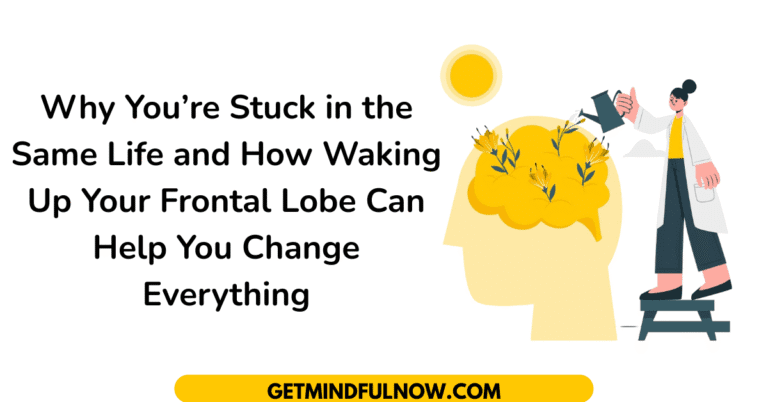Why We Keep Promising Ourselves We’ll Change And Still Don’t
Let me be honest: I used to swear on my life, my future, and every last nerve that this time I was going to change. I would sleep better, start reading the book, stop overthinking, not getting in emotional fight with my mom, not spiral into the same old patterns. And yet, by the end of the day? Same mess. Same regret.
You can swear on every holy thing, but if the part of your brain that controls your behavior isn’t running the show, nothing changes.
Most of us are living on autopilot, reacting, numbing, scrolling, complaining, and it’s not because we’re lazy. It’s because our frontal lobe, the seat of decision, focus, and personal transformation, is half asleep.
The Part of Your Brain That Makes You, You
Back in 1848, Phineas Gage survived what should have been impossible: a 3-foot iron rod shot through his skull and out the other side. The doctors at the time assumed he’d just damaged some “useless” brain matter. But when his entire personality changed, when the kind, steady man became reckless, rude, and impulsive, it shattered what people thought they knew about the brain.

This was the first real clue that the frontal lobe is where our “self” lives, and it kicked off a whole new understanding of human behavior. Who we are, our morals, dreams, decisions, sits right behind the forehead.
Years later, lobotomies(damaging your frontal lobe surgically) became a thing, literally cutting into people’s frontal lobes to control behavior. But those people didn’t just lose anger or anxiety. They lost drive, purpose, decision-making, joy, depth, everything that makes a human human.

And the sad truth? Most of us today are walking around self-lobotomized without a single surgery. Instead of a scalpel, it’s the constant flood of digital noise, endless stress, mindless habits, and emotional overwhelm that keep our frontal lobes shut down. We’re reactive, scattered, and stuck, because this vital part of the brain isn’t fully awake. And we’re paying the price in mental exhaustion, chronic stress, and a deep sense of disconnection from meaning.
Symptoms? They’re everywhere: brain fog, impulsivity, ADHD-like struggles, inability to plan, inability to stick with anything hard. It’s not your willpower. It’s your brain’s leader being asleep.

The Superpower You Forgot You Have
Your frontal lobe makes up 30-40% of your neocortex, that’s massive compared to any animal on earth. It’s why you can:
- Plan a future that doesn’t exist yet.
- Say no to something tempting but destructive.
- Focus deeply on a meaningful goal.
- Alignment in intention and actions
Without it running strong, you live in short loops: survive, react, distract, repeat. Research shows: an active frontal lobe reduces cortisol, improves emotional control, and makes you capable of doing hard things without drowning in overwhelm.
The best part? It’s trainable.
What Happens When The Frontal Lobe Sleeps Too Long
When your frontal lobe is offline, you:
- Lose focus in seconds.
- Feel stuck in sameness.
- Snap emotionally or spiral into old patterns.
- Feel low-key dead inside but can’t explain why.
The brain literally runs on default circuits, habits you didn’t consciously choose. These defaults are built from past memories, old emotional patterns, repeated behaviors, and outdated beliefs. When the frontal lobe isn’t engaged, the lower parts of the brain, your survival wiring, take over. This is the part of you that sticks to comfort, familiarity, and sameness, even when it’s making you miserable.
Without the “CEO” of the brain giving fresh commands, the mind runs on auto: the same reactions, the same triggers, the same emotional habits. Most people only use their frontal lobe for surface-level stuff like picking out an outfit or deciding what to eat, never for the deep, meaningful choices that actually change their life.
And because the brain and body get comfortable with the known, even when the known is toxic, any shift toward something new creates discomfort. The unknown feels unsafe, so we pull back. We avoid. We stay the same.
It’s not just a mental thing, it’s biological. High cortisol, nervous system dysregulation, emotional chaos. The longer this goes on, the harder it feels to break free.
The Science of Waking Up Your Brain
If your life has been stuck on replay, it’s because the part of your brain responsible for intention, the frontal lobe, has gone quiet. Intention is the ability to imagine something different and then choose to act in alignment with that vision. That’s what the frontal lobe does best: it lets you override the old programs.
Every invention, breakthrough, or impossible story you’ve ever heard, from people defying odds to creating change no one believed in, started with this part of the brain lit up and leading. The majority always called them crazy at first. But these people weren’t running on old emotions or memories, they were running on vision.
The Crown Connection: Ancient Clues
The crown that kings wore? It wasn’t just for looks. It sat over the frontal lobe, symbolizing wisdom, vision, higher consciousness. The crown chakra in spiritual practice reflects this same concept: awakening the higher mind beyond survival.
No crown, no focus, no leadership, internally or externally. We’ve forgotten this ancient wisdom. And most people today are proof.
Research proves that meditation increases blood flow to the frontal lobe, calming the primitive survival brain and improving focus, resilience, and emotional balance. In fact, brain scans show that even short daily practice can strengthen this area, with measurable changes in emotional regulation, decision-making, and stress reduction. Even small consistent practice rewires this pathway.
The brain also thrives on novelty and learning, both fire up the frontal lobe. That could mean learning a language, practicing an instrument, or simply taking a new route to work. The CEO steps in when there’s something new to lead, but when life is just a repeat of yesterday, the boss checks out and hands the day to the autopilot staff.
Long-term meditators like Buddhist monks have been studied to show remarkable increases in prefrontal activity. They aren’t born special, they trained their brains to live from higher mind over lower survival instinct.
It’s not magic. It’s what your brain was built to do, when you decide to lead instead of loop.
What Actually Happens When You Activate Your Frontal Lobe
When you flip this switch back on:
- You focus longer.
- You stop being emotionally hijacked every five minutes.
- Your mind stops racing, and you finally get still.
- Your actions and intentions are aligned.
The frontal lobe literally turns down the noise, quieting emotions, sensory overload, motor restlessness. That’s why deep meditation stills the body, it slows everything unnecessary down so your mind can lead.
How to Wake It Up (And Keep It Awake)
What worked for me:
- Daily Mental Rehearsal: I imagine who I want to be and practice feeling it. The brain learns through repetition, even imagined repetition.
- Shadow Work: Work on those hidden part of your personality causing your auto emotional reactions.
- Meditation: Even 30 minutes a day can increase frontal lobe activity. Messy counts. Stillness grows.
- Learn or Do Something New: Read something you don’t usually read. Try a skill. Challenge the brain = grow the brain.
- Impulse Control: Start with tiny things: delay reactions, pause before the old pattern kicks in. Every small win strengthens this part of the brain.
- Crown Visualization: Call me woo, but during meditation, I visualize golden light at the top of my head. It reminds me to rise above the old mind and lead with the new one.
Lead Your Life or Stay on Autopilot
You were designed for more than emotional survival. The frontal lobe is your key to becoming, not just existing.
Start today. Pick one small thing: a twenty-minute meditation, one new skill, one moment of pause before reacting. Not perfect. Not polished. Just willing. Every small step rewires the brain toward the life you actually want.
Wake up your brain. Your life will follow.
Want more? Join my newsletter or follow me on Threads and let’s rise together.








